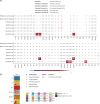tRNAviz: explore and visualize tRNA sequence features
- PMID: 31127306
- PMCID: PMC6602477
- DOI: 10.1093/nar/gkz438
tRNAviz: explore and visualize tRNA sequence features
Abstract
Transfer RNAs (tRNAs) are ubiquitous across the tree of life. Although tRNA structure is highly conserved, there is still significant variation in sequence features between clades, isotypes and even isodecoders. This variation not only impacts translation, but as shown by a variety of recent studies, nontranslation-associated functions are also sensitive to small changes in tRNA sequence. Despite the rapidly growing number of sequenced genomes, there is a lack of tools for both small- and large-scale comparative genomics analysis of tRNA sequence features. Here, we have integrated over 150 000 tRNAs spanning all domains of life into tRNAviz, a web application for exploring and visualizing tRNA sequence features. tRNAviz implements a framework for determining consensus sequence features and can generate sequence feature distributions by isotypes, clades and anticodons, among other tRNA properties such as score. All visualizations are interactive and exportable. The web server is publicly available at http://trna.ucsc.edu/tRNAviz/.
© The Author(s) 2019. Published by Oxford University Press on behalf of Nucleic Acids Research.
Figures



References
-
- Schimmel P. The emerging complexity of the tRNA world: mammalian tRNAs beyond protein synthesis. Nat. Rev. Mol. Cell Biol. 2018; 19:45–58. - PubMed
Publication types
MeSH terms
Substances
Grants and funding
LinkOut - more resources
Full Text Sources
Other Literature Sources
Molecular Biology Databases

